
Pope Callixtus II or Callistus II, born Guy of Burgundy, was head of the Catholic Church and ruler of the Papal States from 1 February 1119 to his death in 1124. His pontificate was shaped by the Investiture Controversy, which he was able to settle through the Concordat of Worms in 1122.
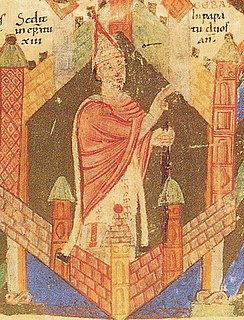
Pope Victor II, born Gebhard of Dollnstein-Hirschberg, was the head of the Catholic Church and ruler of the Papal States from 13 April 1055 until his death in 1057. Victor II was one of a series of German-born popes who led Gregorian Reform.

The Salian dynasty or Salic dynasty was a dynasty in the High Middle Ages. The dynasty provided four kings of Germany (1024–1125), all of whom went on to be crowned Holy Roman emperors (1027–1125).
Pope Paschal II, born Ranierius, was head of the Catholic Church and ruler of the Papal States from 13 August 1099 to his death in 1118. A monk of the Abbey of Cluny, he was created the cardinal-priest of San Clemente by Pope Gregory VII (1073–85) in 1073. He was consecrated as pope in succession to Pope Urban II (1088–99) on 19 August 1099. His reign of almost twenty years was exceptionally long for a medieval pope.

Pope Damasus II was the head of the Catholic Church and ruler of the Papal States from 17 July 1048 to his death on 9 August that same year. He was the second of the German pontiffs nominated by Emperor Henry III. A native of Bavaria, he was the third German to become pope and had one of the shortest papal reigns.
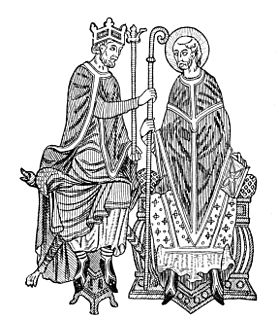
The Investiture Controversy, also called Investiture Contest, was a conflict between the church and the state in medieval Europe over the ability to choose and install bishops (investiture) and abbots of monasteries and the pope himself. A series of popes in the 11th and 12th centuries undercut the power of the Holy Roman Emperor and other European monarchies, and the controversy led to nearly 50 years of civil war in Germany….

Dagobert was the first Archbishop of Pisa and the second Latin Patriarch of Jerusalem after the city was captured in the First Crusade.
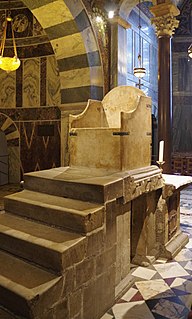
King of the Romans was the title used by the German king following his election by the princes from the reign of Henry II onward. The title predominantly amounted to being the emperor of the Holy Roman Empire, a title long dependent upon coronation by the pope.

Guibert or Wibert of Ravenna was an Italian prelate, archbishop of Ravenna, who was elected pope in 1080 in opposition to Pope Gregory VII and took the name Clement III. Gregory was the leader of the movement in the church which opposed the traditional claim of European monarchs to control ecclesiastical appointments, and this was opposed by supporters of monarchical rights led by the Holy Roman Emperor. This led to the conflict known as the Investiture Controversy. Gregory was felt by many to have gone too far when he excommunicated the Holy Roman Emperor Henry IV and supported a rival claimant as emperor, and in 1080 the pro-imperial Synod of Brixen pronounced that Gregory was deposed and replaced as pope by Guibert.
Theodoric was an antipope in 1100 and 1101, in the schism that began with Wibert of Ravenna in 1080, in opposition to the excesses of Pope Gregory VII and in support of the Emperor Henry IV.
Adalbert was elected pope of the Catholic Church in February 1101 and served for 105 days. He was a candidate of the Roman party opposed to Pope Paschal II and is regarded today as an antipope. Prior to his election he was created a cardinal by the antipope Clement III. He was captured by partisans of Paschal II and forced to live out his days as a monk.

Herman(n) of Salm, also known as Herman(n) of Luxembourg, the progenitor of the House of Salm, was Count of Salm and elected German anti-king from 1081 until his death.

Ruthard was Archbishop of Mainz from 1089 to 1109, and a leading opponent of the Emperor Henry IV and his antipope Clement III. He spent nearly eight years in exile because of his opposition, and played a part in the successful revolt of Henry V against his father.
The Great Saxon Revolt was a civil war fought between 1077 and 1088, early in the history of the Holy Roman Empire. The revolt was led by a group of opportunistic German princes who elected as their figurehead the duke of Swabia, Rudolf of Rheinfeld, who became the anti-king. Rudolf was a two-way brother-in-law of the young Henry IV, Holy Roman Emperor, who had been crowned at the age of six and had taken the reins of power at age sixteen. The Great Revolt followed the Saxon Rebellion of 1073–75.
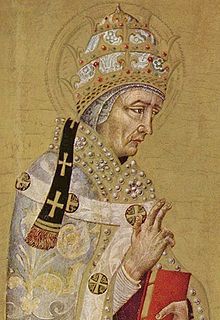
The selection of the pope, the bishop of Rome and supreme pontiff of the Roman Catholic Church, prior to the promulgation of In nomine Domini in 1059 varied throughout history. Popes were often appointed by their predecessors or by political rulers. While some kind of election often characterized the procedure, an election that included meaningful participation of the laity was rare, especially as the popes' claims to temporal power solidified into the Papal States. The practice of papal appointment during this period would later result in the jus exclusivae, i.e., a right to veto the selection that Catholic monarchs exercised into the twentieth century.

A papal election subsequent to the death of Pope Victor III in 1087 was held on 12 March 1088. Six cardinal-bishops, assisted by two lower-ranking cardinals, elected Cardinal-Bishop of Ostia Odon de Lagery as the new Pope. He assumed the name Urban II.

With a long history as a vantage point for anti-popes forces threatening Rome, Viterbo became a papal city in 1243. During the later thirteenth century, the ancient Italian city of Viterbo was the site of five papal elections and the residence of seven popes and their Curias, and it remains the location of four papal tombs. These popes resided in the Palazzo dei Papi di Viterbo alongside the Viterbo Cathedral intermittently for two decades, from 1257 to 1281; as a result, the papal palace in Viterbo, with that in Orvieto, are the most extensive thirteenth-century papal palaces to have survived.
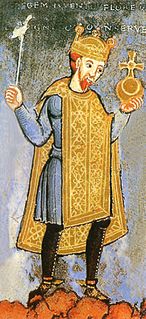
The history of the papacy from 1046 to 1216 was marked by conflict between popes and the Holy Roman Emperor, most prominently the Investiture Controversy, a dispute over who— pope or emperor— could appoint bishops within the Empire. Henry IV's Walk to Canossa in 1077 to meet Pope Gregory VII (1073–85), although not dispositive within the context of the larger dispute, has become legendary. Although the emperor renounced any right to lay investiture in the Concordat of Worms (1122), the issue would flare up again.

Henry IV was Holy Roman Emperor from 1084 to 1105, King of Germany from 1054 to 1105, King of Italy and Burgundy from 1056 to 1105, and Duke of Bavaria from 1052 to 1054. He was the son of Henry III, Holy Roman Emperor—the second monarch of the Salian dynasty—and Agnes of Poitou. After his father's death on 5 October 1056, Henry was placed under his mother's guardianship. She made grants to German aristocrats to secure their support. Unlike her late husband, she could not control the election of the popes, thus the idea of the "liberty of the Church" strengthened during her rule. Taking advantage of her weakness, Archbishop Anno II of Cologne kidnapped Henry in April 1062. He administered Germany until Henry came of age in 1065.
The imperial election of 1346 in the Holy Roman Empire was orchestrated by Pope Clement VI after the pope had pronounced the deposition of the Emperor Louis IV. The pope's candidate, Charles of Moravia, was duly elected by five of the imperial electors at Rhense on 11 July.















